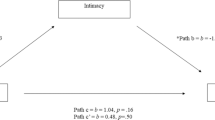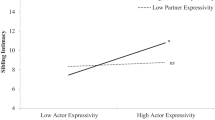Abstract
The sibling relationship has been deemed the quintessential “love-hate relationship.” Sibling relationships have also been found to have both positive and negative impacts on the adjustment of youth. Unlike previous research, however, the present study examined the associations between siblings’ positive and negative body-related disclosures with relationship quality and body-esteem. Additionally, ordinal position, individual sex, and sibling sex composition were tested as moderators. Participants included 101 predominantly White and middle class adolescent sibling dyads (54 % female adolescents, with relatively equal sibling gender compositions). Older siblings were, on average, 16.46 (SD = 1.35) years old with younger siblings an average of 13.67 (SD = 1.56) years. Adolescents completed questionnaires and data were analyzed using Actor-Partner Interdependence Modeling, which focused on disclosure to and from dyad members. In general, sibling body-related disclosure was positive for the quality of the sibling relationship, regardless of the valance of disclosure. Also, adolescents’ body esteem was greater when adolescents reported disclosing (i.e., actor-effects) about positive or negative body issues to their siblings (particularly for females). Conversely, when adolescents received positive or negative body-related disclosures from their siblings (i.e., partner-effects), adolescents reported lower levels of body esteem (particularly for girls and younger siblings). Thus, the impact of body-related disclosure on adolescents’ feelings of body esteem appear to be associated more with whether they are the discloser or the one being disclosed to, while the impact on the quality of the relationship has simply more to do with whether or not they are generally disclosing to one another.

Similar content being viewed by others
References
Adams, R. E., & Laursen, B. (2007). The correlates of conflict: Disagreement is not necessarily detrimental. Journal of Family Psychology, 21, 445–458. doi:10.1037/0893-3200.21.3.445.
Aiken, L. S., & West, S. G. (1991). Multiple regression: Testing and interpreting interactions. Thousand Oaks: Sage Publications Inc.
Ata, R. N., & Ludden, A. B. (2007). The effects of gender and family, friend, and media influences on eating behaviors and body image during adolescence. Journal of Youth and Adolescence, 36, 1024–1037. doi:10.1007/s10964-006-9159-x.
Baxter, L. A. (2010). Voicing relationships: A dialogic perspective. Thousand Oaks, CA: Sage Publications.
Branje, S., van Lieshout, C. F. M., van Aken, M. A. G., & Haselager, G. J. T. (2004). Perceived support in sibling relationships and adolescent adjustment. Journal of Child Psychology and Psychiatry, 48, 1385–1939. doi:10.1111/j.1469-7610.2004.00332.x.
Britton, L. E., Martz, D. M., Bazzini, D. G., Curtin, L. A., & LeaShomb, A. (2006). Fat talk and self-presentation of body image: Is there a social norm for women to self-degrade? Body Image, 3, 247–254. doi:10.1016/j.bodyim.2006.05.006.
Brody, G. H. (2004). Siblings’ direct and indirect contributions to child development. Current Directions in Psychological Science, 13, 124–126. doi:10.1111/j.0963-7214.2004.00289.x.
Buhrmester, D. (1992). The developmental courses of sibling and peer relationships. In F. Boer & J. Dunn (Eds.), Children’s sibling relationships: Developmental and clinical issues (pp. 19–39). New Jersey: Lawrence Erlbaum Associates, Publishers.
Buhrmester, D., & Furman, W. (1990). Perceptions of sibling relationships during middle childhood and adolescence. Child Development, 61, 1387–1398. doi:10.2307/1130750.
Buhrmester, D., Furman, W., Wittenberg, M. T., & Reis, H. T. (1988). Five domains of interpersonal competence in peer relationships. Journal of Personality and Social Psychology, 55, 991–1008. doi:10.1037/0022-3514.55.6.991.
Bumpus, M. F., & Rodgers, K. B. (2009). Parental knowledge and its sources: Examining the moderating roles of family structure and race. Journal of Family Issues, 30, 1356–1378. doi:10.1177/0192513X09334154.
Centers for Disease Control and Prevention (2009). Body mass index. Retrieved from http://www.cdc.gov/healthyweight/assessing/bmi/adult_bmi/english_bmi_calculator/bmi_calculator.html.
Chan, N. P., Choi, K. C., Nelson, E. A., Sung, R. Y., Chan, J. C., & Kong, A. P. (2013). Self-reported body weight and height: An assessment tool for identifying children with overweight/obesity status and cariometabolic risk factors clustering. Maternal Child Health Journal, 17, 282–291. doi:10.1007/s10995-012-0972-4.
Cicirelli, V. G. (1989). Feelings of attachment to siblings and well-being in later life. Psychology and Aging, 4, 211–216. doi:10.1037/0882-7974.4.2.211.
Clark, P. M., Murnen, S. K., & Smolak, L. (2010). Development and psychometric evaluation of a quantitative measure of ‘‘fat talk”. Body Image, 7, 1–7. doi:10.1016/j.bodyim.2009.09.006.
Craig, A., Martz, D., & Bazzini, D. (2006). Peer pressure to “fat talk”: Does audience type influence how women portray their body image? Eating Behaviors, 8, 244–250. doi:10.1016/j.eatbeh.2006.06.006.
Dijkstra, P., & Barelds, D. P. H. (2011). Women’s meta-perceptions of attractiveness and their relations to body image. Body Image: An International Journal of Research, 8, 74–77. doi:10.1016/j.bodyim.2010.09.007.
Dunn, J. (1998). Siblings, emotion and the development of understanding. In S. Braten (Ed.), Intersubjective communication and emotion in early ontogeny (pp. 158–168). Paris: Cambridge University Press.
Elkind, D. (1967). Cognitive structure and adolescent experience. Adolescence, 2, 427–434.
Engeln, R., Sladek, M. R., & Waldron, H. (2012). Body talk among college men: Content, correlates, and effects. Body Image, 10, 300–308. doi:10.1016/j.bodyim.2013.02.001.
Festinger, L. (1954). A theory of social comparison processes. Human Relations, 7, 117–140. doi:10.1177/001872675400700202.
Furman, W., & Buhrmester, D. (1985). Children’s perceptions of the personal relationships in their social networks. Developmental Psychology, 21, 1016–1024. doi:10.1037/0012-1649.21.6.1016.
Furman, W., & Buhrmester, D. (1992). Age and sex differences in perceptions of networks of personal relationships. Child Development, 63, 103–115. doi:10.2307/1130905.
Gardner, R. M., Sorter, R. G., & Friedman, B. N. (1997). Developmental changes in children’s body images. Journal of Social Behavior and Personality, 12, 1019–1036.
Harter, S. (1986). Cognitive-developmental processes in the integration of concepts about emotions and the self. Social Cognition, 4, 119–151. doi:10.1521/soco.1986.4.2.119.
Howe, N., Aquan-Assee, J., & Bukowski, W. M. (1995). Self-disclosure and the sibling relationship: What did Romulus tell Remus? In K. J. Rotenberg (Ed.), Disclosure processes in children and adolescents (pp. 78–99). NY: Cambridge University Press.
Howe, N., Aquan-Assee, J., Bukowski, W. M., Lehoux, P. M., & Rinaldi, C. M. (2001). Siblings as confidants: Emotional, understanding, relationship warmth, and sibling self-disclosure. Social Development, 10, 439–454. doi:10.1111/1467-9507.00174.
Howe, N., Aquan-Assee, J., Bukowski, W. M., Rinaldi, C. M., & Lehoux, P. M. (2000). Sibling self-disclosure in early adolescence. Merrill-Palmer Quarterly, 46, 653–671.
Jourard, S. M. (1971). Self-disclosure: An experimental analysis of the transparent self. New York, NY: Macmillan.
Karos, L. K., Howe, N., & Aquan-Assee, J. (2007). Reciprocal and complementary sibling interactions, relationship quality and socio-emotional problem solving. Infant and Child Development, 16, 577–596. doi:10.1002/icd.492.
Kenny, D. A., Kashy, D. A., & Cook, W. L. (2006). Dyadic data analysis. New York, NY: Guilford Press.
Killoren, S. E., & Roach, A. L. (2014). Sibling conversations about dating and sexuality: Sisters as confidants, sources of support, and mentors. Family Relations, 63, 232–243. doi:10.1111/fare.12057.
Lee, H., Damhorst, M. L., & Ogle, J. P. (2009). Body satisfaction and attitude theory: Linkages with normative compliance and behaviors undertaken to change the body. Family and Consumer Sciences Research Journal, 37, 466–488. doi:10.1177/1077727X09333165.
McHale, S. M., Updegraff, K. A., & Whiteman, S. D. (2012). Sibling relationships and influences in childhood and adolescence. Journal of Marriage and Family, 74, 913–930. doi:10.1111/j.1741-3737.2012.01011.x.
McNelles, L. R., & Connolly, J. A. (1999). Intimacy between adolescent friends: Age and gender differences in intimate affect and intimate behaviors. Journal of Research on Adolescence, 9, 143–159. doi:10.1207/s15327795jra0902_2.
Mendelson, B. K., & White, D. R. (1982). Relation between body-esteem and self-esteem of obese and normal children. Perceptual and Motor Skills, 54, 899–905. doi:10.2466/pms.1982.54.3.899.
Nichter, M. (2000). Fat talk: What girls and their parents say about dieting. Cambridge, MA: Harvard University Press.
O’Dea, J. A., & Caputi, P. (2001). Association between socioeconomic status, weight, age, and gender, and the body image and weight control practices of 6-to 19-year-old children and adolescents. Health Education Research, 16, 521–532. doi:10.1093/her/16.5.521.
Ogle, J. P., & Damhorst, M. L. (2003). Mothers and daughters: Interpersonal approaches to body and dieting. Journal of Family Issues, 24, 448–487. doi:10.1177/0192513X02250826.
Pearce, W. B., & Sharp, S. M. (1973). Self-disclosing communication. Journal of Communication, 23, 409–425. doi:10.1111/j.1460-2466.1973.tb00958.x.
Petronio, S. (2002). Boundaries of privacy: Dialectics of disclosure. Albany, NY: State University of New York Press.
Phares, V., Steinberg, A. R., & Thompson, J. K. (2004). Gender differences in peer and parental influences: Body image disturbance, self-worth, and psychological functioning in preadolescent children. Journal of Youth and Adolescence, 33, 421–429. doi:10.1023/B:JOYO.0000037634.18749.20.
Poran, M. A. (2006). The politics of protection: Body image, social pressures, and the misrepresentation of young black women. Sex Roles, 55, 739–755. doi:10.1007/s11199-006-9129-5.
Reis, H. T., & Shaver, P. (1988). Intimacy as an interpersonal process. In S. Duck (Ed.), Handbook of personal relationships (pp. 367–389). Chichester, England: Wiley.
Rose, A. J. (2002). Co-rumination in the friendships of girls and boys. Child Development, 73, 1830–1843. doi:10.1111/1467-8624.00509.
Schafer, J. L. (1997). Analysis of incomplete multivariate data. London: Chapman & Hall.
Smetana, J. G., Metzger, A., Gettman, D. C., & Campione-Barr, N. (2006). Disclosure and secrecy in adolescent-parent relationships. Child Development, 77, 201–217. doi:10.1111/j.1467-8624.2006.00865.x.
Stice, E., & Bearman, S. K. (2001). Body-image and eating disturbances prospectively predict increases in depressive symptoms in adolescent girls: A growth curve analysis. Developmental Psychology, 37, 597–607. doi:10.1037/0012-1649.37.5.597.
Stice, E., Maxfield, J., & Wells, T. (2003). Adverse effects of social pressure to be thin on young women: An experimental investigation of the effects of ‘fat talk’. International Journal of Eating Disorders, 34, 108–117. doi:10.1002/eat.10171.
Tiggemann, M., & Wilson-Barrett, E. (1998). Children’s figure ratings: Relationship to self-esteem and negative stereotyping. International Journal of Eating Disorders, 23, 83–88. doi:10.1002/(SICI)1098-108X(199801)23:1<83:AID-EAT10>3.0.CO;2-O.
Tucker, C. J., McHale, S. M., & Crouter, A. C. (2001). Conditions of sibling support in adolescence. Journal of Family Psychology, 15, 254–271. doi:10.1037/0893-3200.15.2.254.
Tucker, C. J., & Winzeler, A. (2007). Adolescent siblings’ daily discussions: Connections to perceived academic, athletic, and peer competency. Journal of Research on Adolescence, 17, 145–152. doi:10.1111/j.1532-7795.2007.00515.x.
Updegraff, K. A., McHale, S. M., Whiteman, S. D., Thayer, S. M., & Delgado, M. Y. (2005). Adolescent sibling relationships in Mexican American families: Exploring the role of familism. Journal of Family Psychology, 19, 512–522. doi:10.1037/0893-3200.19.4.512.
Vincent, M. A., & McCabe, M. P. (2000). Gender differences among adolescents in family, and peer influences on body dissatisfaction, weight loss, and binge eating behaviors. Journal of Youth and Adolescence, 29, 205–221. doi:10.1023/A:1005156616173.
Wichstrom, L. (1999). The emergence of gender difference in depressed mood during adolescence: The role of intensified gender socialization. Developmental Psychology, 35, 232–245. doi:10.1037/0012-1649.35.1.232.
Acknowledgments
Kelly Bassett Greer, Nicole Campione-Barr, and Anna K. Lindell were all in the Department of Psychological Sciences at the University of Missouri at the time this research was conducted. The study was conducted in partial fulfillment of the first-author’s doctoral degree requirements. We would like to thank the Columbia Public School District and the many families who participated in this research, as well as our undergraduate research assistants for their participation with family visits and data entry. We are grateful to Anna Lindell for reading and editing earlier drafts of the manuscript. Finally, we thank the University of Missouri Research Board and Research Council for their support of this research.
Author Contributions
KBG conceived of the study, participated in its design and coordination (as part of her dissertation and completion of Ph.D. degree requirements) and drafted the initial manuscript; NCB participated in the conception and design, aided in analytical processes and interpretation, and revised initial manuscript. AKL aided in analytical processes and revision of manuscript. All authors read and approved the final manuscript.
Author information
Authors and Affiliations
Corresponding author
Rights and permissions
About this article
Cite this article
Greer, K.B., Campione-Barr, N. & Lindell, A.K. Body Talk: Siblings’ Use of Positive and Negative Body Self-Disclosure and Associations with Sibling Relationship Quality and Body-Esteem. J Youth Adolescence 44, 1567–1579 (2015). https://doi.org/10.1007/s10964-014-0180-1
Received:
Accepted:
Published:
Issue Date:
DOI: https://doi.org/10.1007/s10964-014-0180-1




